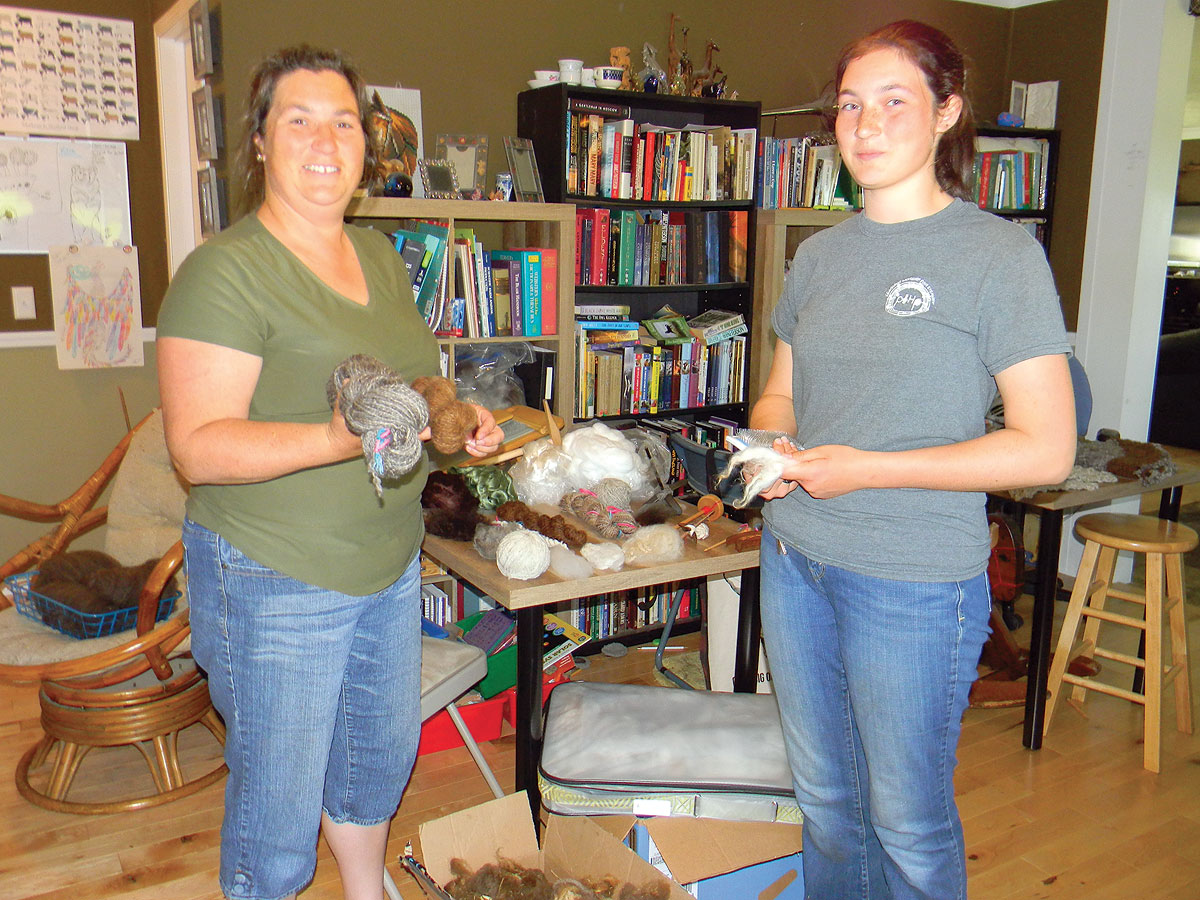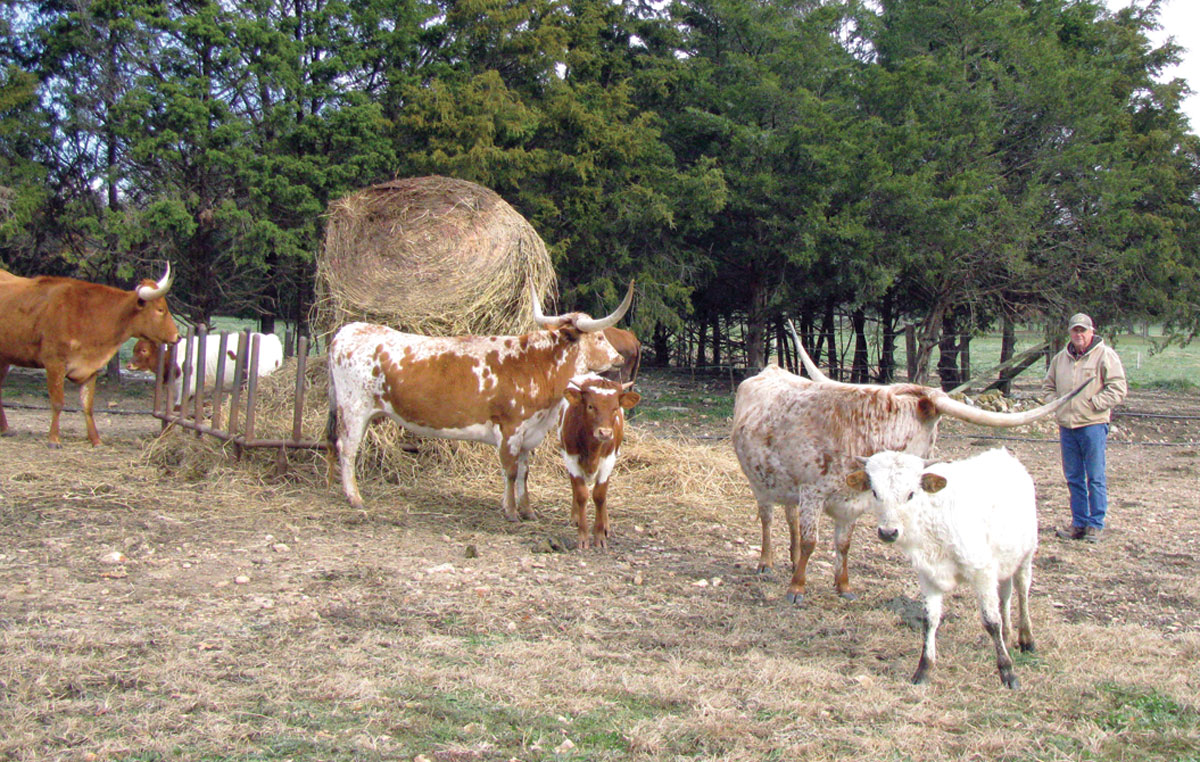
The Kaufman’s convert raw wool from their sheep into finished products
The Kaufman’s farm is perched idyllically at the top of a grass covered hill from which you can see for miles. Pulling in you might hear their two Anatolian guard dogs announcing your approach or the sheeps’ low calls to one another.
It all started more than 15 years ago when Kara saw Shetland sheep at the Vermont fair.
“I fell in love with them right then and there. I love the sheep. I just like sheep,” she said.
Kara finally got to realize her dream in 2016 when she added Shetland sheep to her farm. She didn’t have a spinning wheel or any other equipment for wool processing but she has slowly been adding necessary equipment and knowledge as she goes. She learned how to shear in the spring of 2017.
“It was a horrible experience,” Kara said.
She and daughter Kilee had to learn how to handle the sheep more efficiently to make shearing easier. They watched a lot of videos to learn how to wash and process and spin the wool. They ruined a lot of fleece in the learning process but slowly they have figured out how to do everything through trial and error.
“We shear them in the spring and then we process their wool,” Kara said. “We send some wool now to the mill and that will come back as roving so it’s ready to spin. Otherwise we’ll hand process.”
Shetlands can also “roo,” which means they shed their wool and it can actually be pulled off.
“What happens with rooing is there is a natural break in the fleece from the previous year and it pulls apart, basically. It can make it really difficult to shear them to try to get shears in (the break),” Kara explained.
When the sheep roo, the wool comes off in pieces while shearing can provide a full fleece. Fleece on younger sheep can completely change color as they age and wool can also become coarser. Different areas on the same sheep can even have different types of wool and even different colors of wool.
“These guys are primitive and have not had a lot of human intervention on changing things,” Kara explained. “That’s why you get all these different colors and the variation in their wool. Some of them will have that almost double coat, more like an Icelandic where the outer layer gets longer and more coarse; the under layer is really soft and more fine. I blend (the layers) together; it makes a great sock wool because it’s really sturdy.”
Wool can be tested for micron count which gives an idea of quality.
“These guys generally run in the 20 to 30 range,” Kara said.
Staple length (length of the fleece from sheared end to the tip of the fibers) and crimp are other qualities spinners look for.
“Lots of crimp gives it spring and stretch,” Kara explained. “Shetlands run between a really fine fleece and then they can also go a little more coarse and have a double coat. They can be either single coated, intermediate or double coated. I think that’s what makes it fun. There’s just a bajillion different things you can do with it and your same flock can have everything from long draw to super short and crimpy. I can have anything from a 3-inch staple to a 12-inch staple.”
“The wethers produce more fleece. Some of the best fleece you’re going to get is off a wethered animal because they’re never having any sort of hormone fluctuations,” Kara said.
Any stresses, including hormones, weather fluctuations, heat or other changes, will affect wool quality.
“If you’re a hand spinner and you want a small flock of fiber pets, the wethers are your best option,” Kara said. “If you don’t intend to breed, then you might as well have the best fiber which means wethers. These guys will live 10 to 12 years. I know people with ewes that are 15 or 16.”
Shetlands are low maintenance livestock.
“We don’t do a lot of grain. Most of the summer, they just get enough concentrate to get them to come up at night because they are really kind of grain mongers,” Kara said. “The wethers and the rams are getting plenty of food so they don’t get any grain.”
Sometimes a ram will need a little grain during breeding season. The females get some supplementation during gestation and lactation, if needed, but for the most part the sheep just live off grass and hay.
“They live off air.” Kara added.
“We want our animals to be able to live as natural as they can,” Kara explained.
Due to this decision, they don’t blanket the sheep to protect the fleece from damage. Because of this the Kaufmans throw a lot of damaged wool or wool embedded with hay or straw, but their sheep live much more natural lives.
Shetlands are known for being wonderful mothers. The Kaufmans have never had even first time mothers not able to care for and raise their lambs on their own.
“If mom has a hard time or mom walks away from her lambs, that would be a disqualifier for me,” Kara said. “I wouldn’t keep her. Mothering, ease of lambing and hardiness. Those are huge traits for this breed which makes them really great for homesteads too because they are really easy going, small, easy to handle.
“These guys are also very parasite resistant which is awesome. They are super easy to care for and pretty hardy.”
Kara finds their sheep need deworming and hoof trimming less than once a year. “If you’re going to pick a sheep that’s going to give you the least amount of problems, this is going to be it,” she said. They’re affordable too.”
The Kaufmans sell weaned lambs and occasionally adults as they decide to retain some of the lambs. Fiber is the main goal of most of their buyers but they do sell some for meat as well.
“This is a homestead meat breed because this is as big as they get; the rams only get 100 to 125 pounds; girls are anywhere from 50 to 100 pounds. They are a dual purpose; meat and wool breed. If they don’t get a fleece home, some of them will go to meat,” Kara said.
The sheep that stay provide the Kaufmans with their own fleece to process. What doesn’t get sent to the mill or sold raw, the Kaufmans pull into locks and then soak in soapy water several times to wash it, then rinse with water and vinegar, which neutralizes any soap residue. The wool is then dried.
Once clean and dry, the fiber can be processed into woolen yarn by carding or spinning individual locks. Worsted means the fibers are all hand combed to go in the same direction. “This is probably one of the cleanest methods to get everything out because that brush catches all the little pieces of crud that could be in there. That’s why I love spinning off the locks so much; because it’s so clean and it makes such a smooth yarn too. I just like combing too. Then it’s ready to spin,” Kara explained.
Once the wool is carded or combed, it can either be spun right away or it can be blended before spinning. Blending boards can be used to blend different colors or types of fiber together. More blending makes it smoother and less variegated, while less blending shows more color variety in the yarn.
“That’s another thing we like about the Shetlands is all the natural colors.,” Kara said.
They do buy some other colors at fiber festivals for blending if they want to do something a little bit different. This sometimes includes alpaca or bamboo fiber. However, Kara always comes back to her Shetlands.
“I’m just like, this is so nice,” she said. “Blends are OK and then I go back to straight Shetland and I’m like, this is so easy.”
Raw fleece and finished products such as hand warmers are their best selling products right now. She expects shawls to also sell well. Kara’s daughter, Kilee, knits the shawls and much of the finished products.
The Kaufmans’ goal is to focus mostly on selling roving and yarn from their Shetlands. Kara really enjoys spinning. They may also take custom orders for finished products and they hope to grow enough to be able to have booths at fiber festivals in the future.






